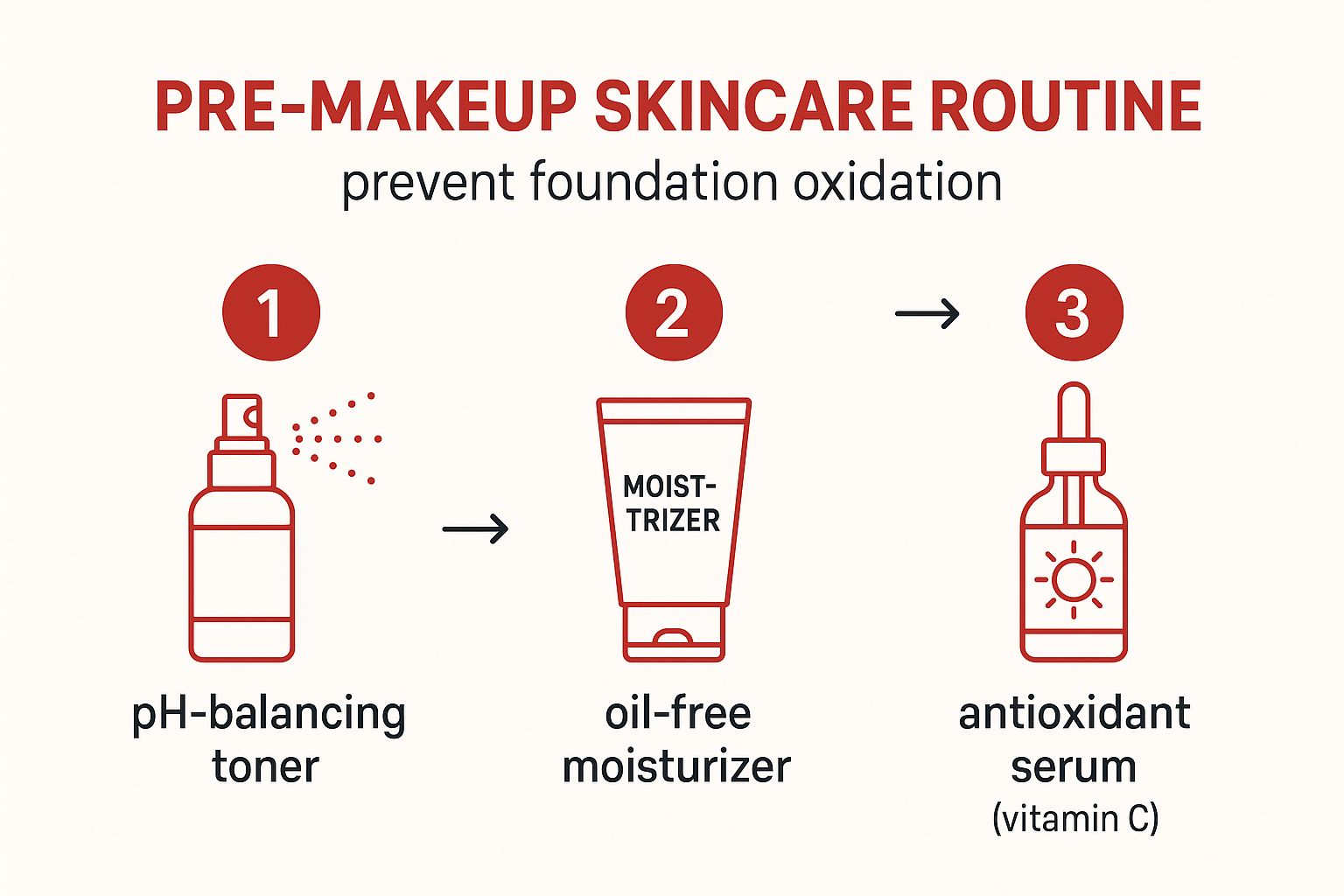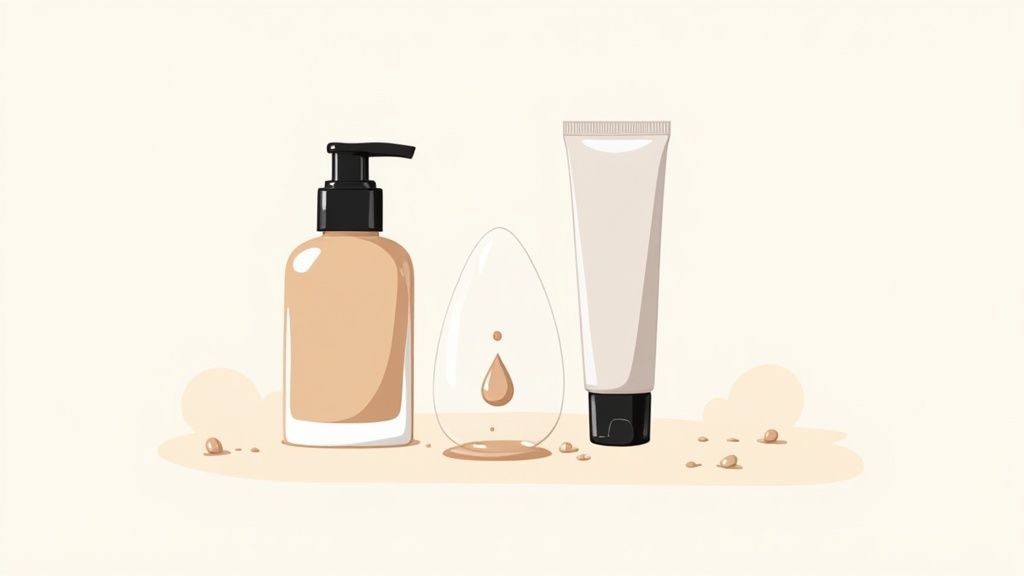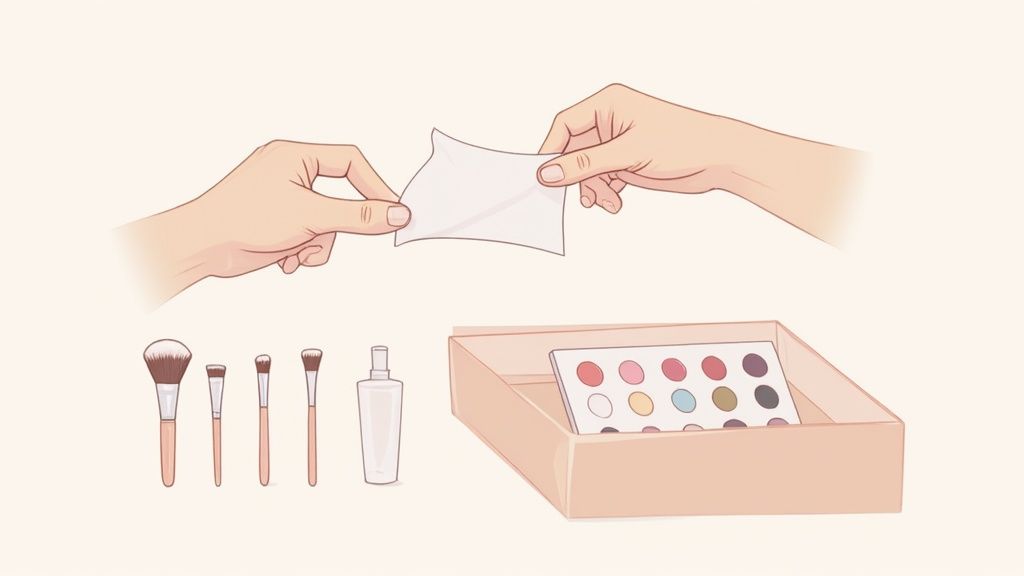The secret to stopping your makeup from changing color is pretty simple: you need to create a barrier between your skin’s natural oils and your foundation. It all comes down to using an oil-controlling primer and picking a stable, long-wear foundation.
Basically, that color shift you’re seeing is just a chemical reaction—and you can totally disrupt it.
Why Your Foundation Changes Color

Ever apply the perfect shade of foundation, only to look in the mirror a few hours later and see a weird, orange-y tint? It’s a super frustrating problem called oxidation, and it’s one of the most common makeup complaints out there. The good news? It’s not just you, and it’s completely fixable once you know what’s going on.
Think about what happens when you slice an apple and leave it on the counter. It starts to brown as it’s exposed to air. A similar thing is happening on your face. Your foundation’s pigments are reacting with a few different things, causing the color to go dark and moody.
The Science Behind the Color Shift
The main culprits messing with your makeup are the natural oils on your skin and your skin's pH level. When those two mix with the pigments in your foundation and get hit with oxygen, the reaction kicks off.
A few things can trigger this or make it happen faster:
- Skin Oils (Sebum): Your skin produces oil to keep itself moisturized, which is great. But those same oils can break down the pigments in your foundation, making them change color. This is why people with oily skin tend to notice oxidation way more.
- Skin pH Imbalance: The natural acidity of your skin plays a role, too. If your skin’s pH is out of whack, it can speed up the whole oxidation process.
- Product Ingredients: Some ingredients, especially pigments like iron oxides, are just more likely to oxidize when they meet oil and air.
The real issue isn't that your foundation is "bad." It's just reacting to your unique skin chemistry. The key to preventing makeup from oxidizing is all about controlling the environment on your skin before you even put foundation on.
Once you get that it’s all about the mix of air, oil, and pigment, you can start building a routine that creates a stable base. This is the first step to making sure your makeup looks just as good at 5 PM as it did at 9 AM.
Build a Skincare Routine to Stop Oxidation
The fight against your foundation turning orange begins way before you even unscrew the cap. Seriously. Your skincare routine is your secret weapon, creating a calm, balanced canvas that makes a huge difference in how your makeup wears throughout the day. This isn't just about slapping on some products; it's a strategy to shut down the very things that cause your foundation to darken in the first place.
To really tackle oxidation, you have to get your morning skincare routine steps down to a science. This sets the stage for a flawless application by keeping oil in check and creating a smooth base. A well-prepped canvas is way less likely to have a bad reaction with your makeup pigments.
Create a Balanced Canvas
Think of your skin as the primer before your primer. If your skin is oily or its pH is out of whack, it’s going to start messing with your makeup immediately.
An easy fix? Work a pH-balancing toner into your routine right after cleansing. This one little step helps bring your skin’s acidity back to normal, making it a much less reactive surface for your foundation.
Next up, be picky about your moisturizer. A heavy, oil-based cream can actually pour fuel on the oxidation fire. Instead, go for a lightweight, oil-free moisturizer. This gives your skin the hydration it needs without adding the extra oil that makes your makeup shift color. You can find more tips on getting your skin ready in our guide about prepping your skin from the inside out.
This simple infographic breaks down the core pre-makeup skincare steps to fight oxidation.

As you can see, layering a toner, moisturizer, and serum creates a protective shield for your skin.
Harness the Power of Antioxidants
Okay, the real game-changer here is an antioxidant serum. Keeping your makeup from oxidizing is all about using ingredients that stop those color-changing chemical reactions in their tracks. This is where products with Vitamin C, Vitamin E, or niacinamide become your best friends.
These serums act like a shield, neutralizing the free radicals on your skin before they can even think about reacting with your foundation’s pigments.
The global market for cosmetic antioxidants was valued at USD 132 million in 2023 and is only expected to grow. That tells you just how much the industry is banking on these powerhouse ingredients. They literally stop the reaction between the air and your skin's oils that leads to that dreaded color change. When you apply an antioxidant serum and let it sink in completely, you’re creating a stable base that will keep your foundation looking true-to-shade for hours.
Select the Right Foundation and Primer

While your skincare routine lays down the perfect canvas, the makeup you choose to put on top is just as critical for keeping that color true all day long. The right formulas can stop oxidation in its tracks, but the wrong ones can actually speed it up. It’s a frustrating truth: not all foundations are created equal.
Your first line of defense is picking a foundation built for stability. Keep an eye out for formulas marketed as long-wear or waterproof. These aren't just buzzwords; they usually mean the product contains film-forming agents that create a flexible, breathable barrier over your skin.
This barrier is a game-changer. It physically separates the foundation's pigments from your skin's natural oils, which dramatically cuts down the chances for that color-changing chemical reaction. There’s a reason the waterproof makeup market was valued at USD 15.85 billion in 2023—we all want makeup that looks the same at 5 p.m. as it did at 9 a.m. You can read more about the growth of waterproof cosmetics on grandviewresearch.com.
Read the Ingredient List
Beyond the marketing claims on the bottle, the ingredient list holds the real secrets. Two things you want to look for are stable pigments and antioxidants.
- Stable Pigments: High-purity pigments are simply less prone to reacting with air or oil and shifting color.
- Antioxidant Additives: Spotting ingredients like Vitamin C or E in your foundation is a huge plus. They work to neutralize oxidation right in the formula itself.
Here's a tip that has saved my makeup more times than I can count: your primer choice matters. A lot. A silicone-based primer is especially brilliant because it creates this silky, smooth layer that oil has a really tough time breaking through. Your foundation sits on top of this barrier, not directly on your skin where all the trouble starts.
To help you shop smarter, I've put together a quick cheat sheet for what to look for—and what to avoid—when you're on the hunt for a new foundation.
Choosing an Oxidation-Resistant Foundation
| Feature | Oxidation-Resistant (What to Look For) | Oxidation-Prone (What to Avoid) |
|---|---|---|
| Formula Type | Long-wear, waterproof, oil-free | Heavy, oil-based formulas |
| Key Ingredients | Silicone, Vitamin C, Vitamin E | High amounts of unstable oils, minimal preservatives |
| Finish | Matte, satin, or "transfer-resistant" | "Dewy" or "glowy" formulas (can contain more oils) |
| Pigments | Coated or high-purity pigments | Lower-grade pigments (often in budget formulas) |
Think of your primer and foundation as a team. By pairing a barrier-forming primer with a stable, long-wear foundation, you're setting up a powerful defense against that dreaded color shift.
Of course, even the best formula won't work if the shade is off from the get-go. If you need a little help finding your perfect match, check out our guide on how to choose the right foundation shade.
Master Your Application and Setting Techniques
How you put on your makeup is just as important as the products you choose. Honestly, it might be more important. The right application methods create a protective barrier that seals in your foundation's true color and defends it against the elements that cause that dreaded color shift.
Create a Barrier Before You Begin
A non-negotiable first step? Primer. Think of a silicone-based primer as an invisible shield. It smooths everything out and creates a physical barrier that separates your skin’s natural oils from your foundation’s pigments. This makes it so much harder for them to mix and go rogue.
Use a Light Hand for a Lasting Finish
The "less is more" philosophy is your best friend when fighting oxidation. Instead of slathering on one thick coat of foundation, try building it up in thin, sheer layers. This approach minimizes the amount of product exposed to air and oil at any given time, which seriously cuts down the chances of a color shift.
Applying your base this way also lets each layer set properly before you add the next. For a really even, seamless blend, a damp sponge works wonders. If you need a few pointers, our guide on how to apply foundation with a sponge can help you nail the technique.
A common mistake is dusting setting powder directly onto oily skin. This can mix the powder with the oil, creating a cakey texture and actually making the color change worse. The pro move is to blot first, powder second.
Grab a blotting sheet and gently press away any excess oil before you even think about powder. This removes the main culprit—the oil—without messing up the makeup underneath.
Lock It All in Place
Finally, you need to set your look for the day. But not all facial mists are created equal. A hydrating mist feels amazing, but a true setting spray contains polymers that create a final, durable film over your makeup. This acts as the ultimate seal against humidity, oil, and air.
Correctly layering products and using these specific application tricks are key to slowing down oxidation. And it's not just us saying it—the growing awareness around these techniques, largely driven by social media, has empowered more people to adopt smarter routines to keep their makeup looking fresh all day. These small adjustments in your routine can make all the difference.
On-the-Go Fixes and Long-Term Habits

Even when you’ve done everything right, life happens. A stressful meeting or a humid commute can challenge your makeup. So, what do you do when the dreaded midday shine appears? Managing oil is your best bet for stopping makeup from oxidizing hours after you've applied it.
Your secret weapon for this is a pack of blotting papers. Seriously. These little sheets are designed to soak up excess oil right off your skin's surface without messing with the makeup underneath. Just press a sheet gently onto your T-zone or any other shiny spots. This gets rid of the oil—oxidation’s primary fuel—without piling on more product that can end up looking cakey.
Build Better Habits for Lasting Results
Beyond the quick fixes, a few long-term habits can make a huge difference in how your makeup wears throughout the day and even how long your products last.
-
Clean Your Tools Religiously: This one is non-negotiable. Your makeup brushes and sponges are basically magnets for oil, dead skin cells, and bacteria. When you use dirty tools, you’re just smearing all those oxidation-causing culprits back onto your face and into your foundation bottle. Try to wash your foundation brushes and sponges at least once a week.
-
Store Makeup Properly: Heat and humidity are the enemies of good makeup. They can break down the preservatives in your foundation, making the formula unstable. Keep your products in a cool, dry place away from direct sunlight. Your steamy bathroom is probably the worst spot for them.
Keeping your tools clean isn't just about avoiding breakouts—it's a critical step in preserving the chemical stability of your makeup. A clean brush not only applies product more evenly but also prevents contamination that can make your foundation change color.
These small, consistent habits mean every application starts fresh, giving your makeup its best shot at staying true to color all day long.
Got Questions About Makeup Oxidation?
Even when you think you've nailed your routine, that dreaded color shift can still feel like a total mystery. It happens to the best of us. Let's dig into some of the questions that always come up when you’re trying to stop your makeup from oxidizing for good.
It's a common worry that adding another layer of product might just make things worse, but—when you do it right—the opposite is often true.
So, Does Setting Powder Make Foundation Oxidize More?
Not if you’re strategic about it. The real problem kicks in when you dust powder directly over excess oil on your face. That combo can create a kind of paste, which is what messes with your foundation's color and gives you that cakey look nobody wants.
Here’s a better way: deal with the oil first.
Grab a blotting sheet and press it onto any shiny spots. This soaks up the sebum without messing up the makeup underneath. Then, you can go in with a light dusting of a finely-milled, translucent setting powder. This locks everything in place without piling on more pigment or kicking off an oxidation reaction.
How Do I Stop My Under-Eye Concealer From Oxidizing?
This is a different beast altogether. The skin under your eyes is super delicate and has barely any oil glands, so when concealer oxidizes here, it’s usually because of how your products are interacting, not because of sebum. The trick is all about hydration and applying in super thin layers.
Always, always start with a hydrating eye cream. Let it sink in completely before you even think about putting on makeup. After that, reach for a lightweight concealer, ideally one with a self-setting formula.
Apply your concealer in whisper-thin layers, building up coverage only where you really need it. Set it immediately with a light sweep of a brightening powder. This locks it in before it has a chance to react with the air or your skincare.
This quick-set method acts like a shield, preserving your concealer’s true color all day long.
Should I Just Buy a Lighter Foundation Shade?
Please don't. This is a super common piece of advice, but it's a risky move that usually backfires. A foundation that’s too light to begin with can turn ashy or grey as it oxidizes. The result is an unnatural finish that looks just as off as a foundation that’s gone too orange.
The only foolproof way is to test foundation properly before you commit.
Swatch a shade you think might work on your jawline while you’re in the store. Then, and this is the important part, walk around for at least 20-30 minutes. Give it time to dry down and react with your skin. The right shade is the one that’s a perfect match after it has fully settled.
Ready to build your perfect, oxidation-proof makeup routine? A flawless base is where it all begins. Discover how Axiology's innovative, mushroom-infused Fungdation can give you buildable coverage while caring for your skin. Explore our collection at www.axiologybeauty.com.





